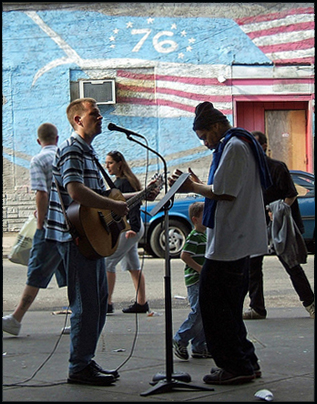
This is the official publication day for Looking Up at the Bottom Line: The Struggle for the Living Wage! by Richard R. Troxell, from Plain View Press. Troxell is in Philadelphia, visiting at the University of Pennsylvania, where the School of Social Policy & Practice is hosting a lecture and booksigning today only. If you’re in the area, it’s at 3601 Walnut St., University Sq., and the event is from 2:30 to 4 PM.
Looking Up at the Bottom Line is largely about veterans. How could it not be, when one-third of the people experiencing homelessness are veterans? Among the unhoused population, the military, as a profession, is woefully over-represented. The homeless vets are the lucky ones. The unlucky ones are dead.
Aaron Glantz, an investigative journalist, studied veterans in the state of California and reported in The Bay Citizen on an appalling situation. He says,
An analysis of official death certificates on file at the State Department of Public Health reveals that more than 1,000 California veterans under 35 died between 2005 and 2008. That figure is three times higher than the number of California service members who were killed in the Iraq and Afghanistan conflicts over the same period.
To make a broad generalization, it looks like the after-effects of having been in the war are killing more service members than the actual war. To make another broad generalization, the government really needs to pay attention to Post Traumatic Stress Disorder (PTSD) and take it seriously.
These guys come back from combat and just jump the track, becoming the poster children for self-destructiveness. Some die in motorcycle wrecks and car crashes, others OD or commit suicide in a variety of more direct ways. Glantz says,
Suicides represented approximately one in five deaths of young veterans, the data showed. Many other deaths resulted from risky behaviors that psychologists say are common symptoms of post-traumatic stress.
Glantz is the author of three books, including The War Comes Home: Washington’s Battle Against America’s Veterans. His recent report is replete with both cold, factual graphs dealing with statistics, and several human-interest stories of individual veterans.
Apparently, the government is not doing a good job on any level, from intervention all the way down to mere record-keeping. Glantz interviewed the director of Veterans for Common Sense, Paul Sullivan, who deplores the attitude shown by the Veterans Administration and the Department of Defense. He told the reporter,
V.A. and D.O.D. appear to have a policy for veterans called ‘Don’t look, don’t find.’
The veterans who die of compulsive risk-taking behavior or outright suicide are called “stateside casualties,” and we can expect a lot more of them, partly because of the delayed impact peculiar to PTSD. Often, it takes a few years for the full effects of PTSD to develop. People can even seem fine… for a while.
Of course, this is nothing new. A vet named Daniel G. Dumas has gathered together some statistics on Vietnam veterans that are just as disheartening. Unfortunately, he doesn’t give the sources of his information, but makes such claims as, “The suicide rate for Vietnam vets is 86% higher than the national average of peers of the same age group.”
Probably nobody can really know these numbers, but there is no doubt that Vietnam veterans experienced unemployment, divorce, incarceration and homelessness at statistical rates out of proportion to their numbers. The claims about Vietnam vets have been contested, but the more careful analysis now being done of the fates of Iraq and Afghanistan veterans indicates that even the wildest guesses about their Vietnam war counterparts might not be too far off the mark.
Reactions?
Source: “After Service, Veteran Deaths Surge,” The Bay Citizen, 10/16/10
Source: “What is a Vietnam Veteran?,” CAPVeterans.com
Image by Tony the Misfit, used under its Creative Commons license.
0


